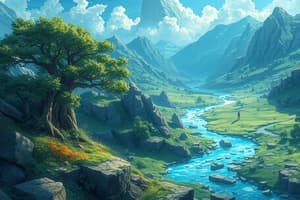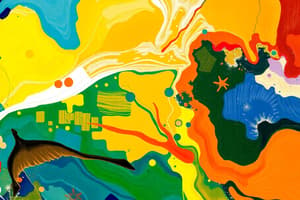Podcast
Questions and Answers
Which environment includes components such as roads and buildings?
Which environment includes components such as roads and buildings?
- Natural Environment
- Spherical Environment
- Biological Environment
- Man-made Environment (correct)
What is a major effect of human activities on the environment?
What is a major effect of human activities on the environment?
- Increasing carbon dioxide levels (correct)
- Maintaining biodiversity
- Harmonizing natural balances
- Enhancing soil fertility
Which of the following refers to the sphere of air surrounding the Earth?
Which of the following refers to the sphere of air surrounding the Earth?
- Biosphere
- Lithosphere
- Hydrosphere
- Atmosphere (correct)
Which component of the natural environment includes plants and animals?
Which component of the natural environment includes plants and animals?
What is the primary reason Earth is unique among planets in the solar system?
What is the primary reason Earth is unique among planets in the solar system?
What type of landform is created when tectonic plates collide?
What type of landform is created when tectonic plates collide?
Which of the following is NOT a type of rock formed through geological processes?
Which of the following is NOT a type of rock formed through geological processes?
What geological feature is primarily caused by plates sliding past each other?
What geological feature is primarily caused by plates sliding past each other?
Which layer of the Earth is described as the uppermost solid layer?
Which layer of the Earth is described as the uppermost solid layer?
Which term describes the preserved remains of ancient organisms typically found in sedimentary rocks?
Which term describes the preserved remains of ancient organisms typically found in sedimentary rocks?
What is formed from the accumulation of ash, rocks, and solidified lava around a volcanic vent?
What is formed from the accumulation of ash, rocks, and solidified lava around a volcanic vent?
Which type of rock is formed when igneous or sedimentary rocks change due to temperature or pressure?
Which type of rock is formed when igneous or sedimentary rocks change due to temperature or pressure?
What geological process leads to the movement of tectonic plates?
What geological process leads to the movement of tectonic plates?
What is a caldera?
What is a caldera?
How do metamorphic rocks relate to the rock cycle?
How do metamorphic rocks relate to the rock cycle?
Which process contributes to the community of volcanic islands?
Which process contributes to the community of volcanic islands?
Which of the following is NOT an example of a metamorphic rock?
Which of the following is NOT an example of a metamorphic rock?
What best describes the relationship between magma and igneous rocks in the rock cycle?
What best describes the relationship between magma and igneous rocks in the rock cycle?
What is the focus of an earthquake?
What is the focus of an earthquake?
How does the Richter scale measure earthquake intensity?
How does the Richter scale measure earthquake intensity?
What landform is created when tectonic plates collide?
What landform is created when tectonic plates collide?
Which of the following is a primary cause of earthquakes?
Which of the following is a primary cause of earthquakes?
What effect do earthquakes have on landforms?
What effect do earthquakes have on landforms?
Which of the following describes a rift formed by separating tectonic plates?
Which of the following describes a rift formed by separating tectonic plates?
What precaution should you take during an earthquake?
What precaution should you take during an earthquake?
What type of rock is characterized by the cooling and solidification of molten material?
What type of rock is characterized by the cooling and solidification of molten material?
Which of the following is a significant consequence of earthquakes?
Which of the following is a significant consequence of earthquakes?
Which earthquake measurement indicates significant potential for damage?
Which earthquake measurement indicates significant potential for damage?
Which layer of the Earth is primarily composed of sial?
Which layer of the Earth is primarily composed of sial?
What was a consequence of the Bhuj earthquake in 2001?
What was a consequence of the Bhuj earthquake in 2001?
What happens to the vibrations of an earthquake?
What happens to the vibrations of an earthquake?
What is the main difference between extrusive and intrusive igneous rocks?
What is the main difference between extrusive and intrusive igneous rocks?
Which of the following is NOT a typical example of a sedimentary rock?
Which of the following is NOT a typical example of a sedimentary rock?
How are sedimentary rocks formed?
How are sedimentary rocks formed?
Which mineral is known as the hardest mineral on Earth?
Which mineral is known as the hardest mineral on Earth?
What characteristic feature distinguishes sedimentary rock layers?
What characteristic feature distinguishes sedimentary rock layers?
Which of these rocks is classified as an intrusive igneous rock?
Which of these rocks is classified as an intrusive igneous rock?
Which of the following statements about minerals is true?
Which of the following statements about minerals is true?
What type of rock is coal classified as?
What type of rock is coal classified as?
What is the approximate radius of the Earth?
What is the approximate radius of the Earth?
Which layer of the Earth is primarily composed of silicates of iron and magnesium?
Which layer of the Earth is primarily composed of silicates of iron and magnesium?
What characterizes the uppermost part of the mantle?
What characterizes the uppermost part of the mantle?
Which statement about the Earth's crust is true?
Which statement about the Earth's crust is true?
What is the state of the outer core?
What is the state of the outer core?
What is the approximate thickness of the lower mantle?
What is the approximate thickness of the lower mantle?
How far below the crust does the upper mantle begin?
How far below the crust does the upper mantle begin?
What is the primary component of the inner core?
What is the primary component of the inner core?
Which characteristic is true about the crust compared to the mantle?
Which characteristic is true about the crust compared to the mantle?
Which part of the mantle is considered semi-molten?
Which part of the mantle is considered semi-molten?
Flashcards
Natural Environment
Natural Environment
The natural surroundings in which organisms live, including the components of the physical environment (temperature, light, air, water, soil, landforms) and biological elements (plants and animals).
Lithosphere
Lithosphere
The part of the Earth made up of rocks and soil, forming the solid outer layer of the planet.
Hydrosphere
Hydrosphere
The part of the Earth composed of all its water, including oceans, lakes, rivers, glaciers, and groundwater.
Atmosphere
Atmosphere
Signup and view all the flashcards
Biosphere
Biosphere
Signup and view all the flashcards
What is the Earth's crust?
What is the Earth's crust?
Signup and view all the flashcards
What is the Earth's mantle?
What is the Earth's mantle?
Signup and view all the flashcards
What is the Upper Mantle?
What is the Upper Mantle?
Signup and view all the flashcards
What is the Lower Mantle?
What is the Lower Mantle?
Signup and view all the flashcards
What is the Earth's Core?
What is the Earth's Core?
Signup and view all the flashcards
What is the Outer Core?
What is the Outer Core?
Signup and view all the flashcards
What is the Inner Core?
What is the Inner Core?
Signup and view all the flashcards
What is the Lithosphere?
What is the Lithosphere?
Signup and view all the flashcards
What are Seismic Waves?
What are Seismic Waves?
Signup and view all the flashcards
What is Seismology?
What is Seismology?
Signup and view all the flashcards
What are rocks?
What are rocks?
Signup and view all the flashcards
What is a mineral?
What is a mineral?
Signup and view all the flashcards
What is rock classification?
What is rock classification?
Signup and view all the flashcards
What are igneous rocks?
What are igneous rocks?
Signup and view all the flashcards
What are intrusive igneous rocks?
What are intrusive igneous rocks?
Signup and view all the flashcards
What are extrusive igneous rocks?
What are extrusive igneous rocks?
Signup and view all the flashcards
What are sedimentary rocks?
What are sedimentary rocks?
Signup and view all the flashcards
What are sedimentary rock layers?
What are sedimentary rock layers?
Signup and view all the flashcards
Fold Mountains
Fold Mountains
Signup and view all the flashcards
Igneous Rock
Igneous Rock
Signup and view all the flashcards
Sedimentary Rock
Sedimentary Rock
Signup and view all the flashcards
Earthquakes
Earthquakes
Signup and view all the flashcards
Fossils
Fossils
Signup and view all the flashcards
What is an earthquake?
What is an earthquake?
Signup and view all the flashcards
What is the focus of an earthquake?
What is the focus of an earthquake?
Signup and view all the flashcards
What is the epicenter of an earthquake?
What is the epicenter of an earthquake?
Signup and view all the flashcards
What is the Richter Scale?
What is the Richter Scale?
Signup and view all the flashcards
What is a seismograph?
What is a seismograph?
Signup and view all the flashcards
What factors influence earthquake damage?
What factors influence earthquake damage?
Signup and view all the flashcards
What are quake-resistant building guidelines?
What are quake-resistant building guidelines?
Signup and view all the flashcards
What is a volcano?
What is a volcano?
Signup and view all the flashcards
What is magma?
What is magma?
Signup and view all the flashcards
What is a volcanic cone?
What is a volcanic cone?
Signup and view all the flashcards
What is a crater?
What is a crater?
Signup and view all the flashcards
What are metamorphic rocks?
What are metamorphic rocks?
Signup and view all the flashcards
Plate Collision
Plate Collision
Signup and view all the flashcards
What is the rock cycle?
What is the rock cycle?
Signup and view all the flashcards
Plate Separation
Plate Separation
Signup and view all the flashcards
What are tectonic processes?
What are tectonic processes?
Signup and view all the flashcards
Plate Sliding
Plate Sliding
Signup and view all the flashcards




